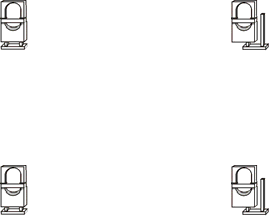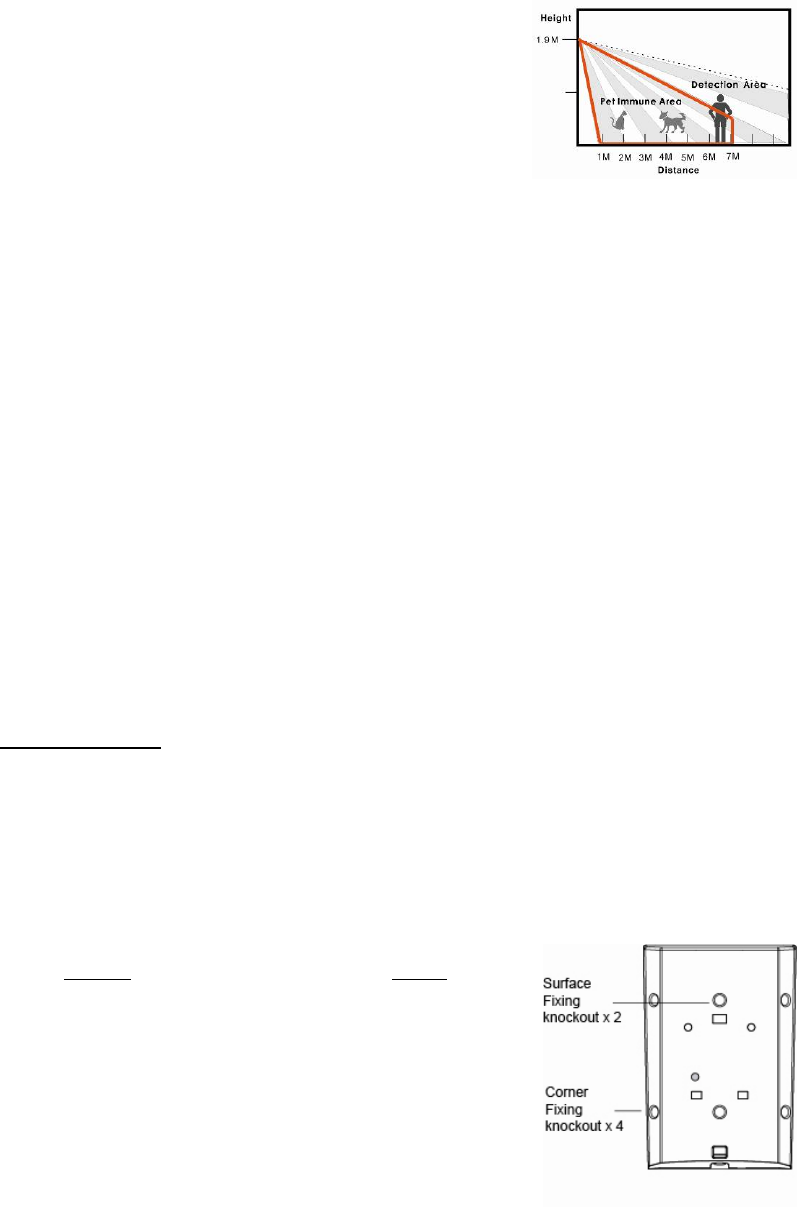Climax Technology Co 852 PIR Motion Sensor Camera User Manual VST 852Pro Ultra NT 20150702
Climax Technology Co Ltd PIR Motion Sensor Camera VST 852Pro Ultra NT 20150702
Users Manual

1
VST-852Pro-Ultra NT PIR Motion Sensor Camera
Introduction
VST-852Po-Ultra is a ZigBee passive infrared (PIR) motion sensor camera with pet-immune function. It
is capable of sending wireless signals and captured images (picture quality of up to 640 x 480 pixels) to
the coordinator in the ZigBee network upon movement detection.
The PIR Camera is designed to give a typical detection range of 12 meters when mounted at 2 meters
above ground. It has a pet-immune range of 7 meters and will not trigger false alarm from you
household pets within this distance.
The PIR Camera utilizes ZigBee technology for wireless signal transmission. ZigBee is a wireless
communication protocol that is reliable and has low power consumption and high transmission efficiency.
Based on the IEEE802.15.4 standard, ZigBee allows a large amount of devices to be included in a
network and coordinated for data exchange and signal transmission
The PIR Camera serves as an end device in the ZigBee network. It can be included in the ZigBee
network to transmit signal upon activation, but cannot permit any other ZigBee device to join the
network through the PIR.
Parts Identification
1. Flash LED
The Flash LED delivers sufficient light for image capture under low
lighting condition.
Both the Flash LED and the Blue LED will flash once when the
Function Button is pressed for 10 seconds to indicate the PIR
Camera has been reset.
2. IR Sensor
The sensor is intended to detect moving objects.
3. PIR Camera Lens
4. Blue LED/Function Button
LED Indication:
The Blue LED lights up in the following conditions:
- The Blue LED flash once every 20 minutes
The PIR Camera has lost connection to its current ZigBee
network.
- The Blue LED lights up for 30 seconds:
The PIR Camera is warming up when fault(s) exists in the PIR
Camera.
- The Blue LED flashes twice quickly:
The PIR Camera has successfully joined a ZigBee network
after factory reset.
- The Blue LED lights up for 2 seconds under normal operation:
The PIR Camera has detected a movement when fault(s)
exists in the PIR Camera.
- The Blue LED flashes rapidly
PIR Camera is transmitting pictures to the coordinator of the
ZigBee network when fault(s) exists in the PIR Camera.
- The Blue LED and Flash LED flash once
PIR Camera has been reset.
Function Button Usage:
- Press the button once to send a supervision signal.
- To reset the PIR Camera:
Press and hold the button for 10 seconds. Release the button
when both the Flash LED and the Blue LED flash once

2
5. Battery Compartment
6. Jumper Switch (JP2)
- Jumper On: After transmitting for a detected movement, any further movement detection will
transmit the event code again (and the captured images) (default).
- Jumper Off: PIR Camera has a “sleep time” of approximately 1 minute to conserve power.
7. Jumper Switch (JP1)
- Jumper On: the Blue LED is enabled (default).
- Jumper Off: the Blue LED is disabled.
8. Battery Insulator
Features
z
z
I
Im
ma
ag
ge
e
C
Ca
ap
pt
tu
ur
re
e
When the alarm system is armed, the PIR Camera will capture 3 alarm images (Quality: 640 x 480
resolution, or VGA) upon movement detection. You can also manually request the PIR Camera to
take a picture through CIE. The captured images will be transferred to ZigBee coordinator or CIE
for user to view.
z
z
W
Wa
ar
rm
m
U
Up
p
P
Pe
er
ri
io
od
d
When the ZigBee network coordinator or system control panel enters arm mode, or when PIR
Camera is put into Test Mode, the PIR Camera will warm up for 30 seconds. Do not trigger the
PIR Camera during the 30-second warm up period. If the PIR Camera is under low battery, the
Blue LED will light up during the warm up period.
z
z
S
Sl
le
ee
ep
p
T
Ti
im
me
er
r
When Jumper Switch 2 is set to Off, the PIR Camera has a “sleep time” of approximately 1
minute to conserve power. After transmitting for a detected movement, the PIR Camera will not
retransmit for 1 minute. Any detected movement during this period will extend the sleep time by
another minute. Continuous movement in front of the PIR Camera will therefore not exhaust the
battery.
z
z
B
Ba
at
tt
te
er
ry
y
a
an
nd
d
L
Lo
ow
w
B
Ba
at
tt
te
er
ry
y
D
De
et
te
ec
ct
ti
io
on
n
The PIR Camera uses two 1.5V “AA” Lithium batteries in series connection as its power source.
The batteries are pre-installed in the PIR Camera. To activate the batteries, pull out the battery
insulator.
The PIR Camera features Low Battery Detection function. When the battery voltage is low, the
PIR Camera will transmit Low Battery signal to the coordinator in ZigBee network. If movement is
detected under Low Battery condition, the Blue LED will light up for 2 seconds.
When changing battery, after removing the old battery, press the Function Button twice to fully
discharge before inserting new batteries
z
z
S
Su
up
pe
er
rv
vi
is
si
io
on
n
The PIR Camera will transmit a supervision signal to report its condition regularly according to user
setting. The factory default interval is 30 minutes. The user can also press the Function Button
once to transmit a supervision signal manually.
z
z
T
Te
es
st
t
M
Mo
od
de
e
z Test mode is for you to check the PIR camera’s detection range (not shooting coverage).
z To enter Test mode, press and hold the Function button over 3 seconds and release the button
to enter the Test mode for 3 minutes.
z The PIR camera will warm up for 30 seconds. Please do not trigger the Camera during this
warming-up period.
z After the warm-up period, you can trigger PIR camera to check IR detection range. If PIR
camera is triggered, the Blue LED will light up for 2 seconds.
Jumper On
The jumper link is inserted
connecting the two pins.
Jumper Of
f
if the jumper link is removed
or “parked” on one pin.
Jumper On
The jumper link is inserted
connecting the two pins.
Jumper Of
f
if the jumper link is removed
or “parked” on one pin.

3
ZigBee Network Setup
z
z
Z
Zi
ig
gB
Be
ee
e
D
De
ev
vi
ic
ce
e
G
Gu
ui
id
de
el
li
in
ne
e
ZigBee is a wireless communication protocol that is reliable, has low power consumption and has
high transmission efficiency. Based on the IEEE802.15.4 standard, ZigBee allows a large amount
of devices to be included in a network and coordinated for data exchange and signal transmission.
Due to the fundamental structure of ZigBee network, ZigBee device will actively seek and join
network after powering on. Since performing a task in connecting network may consume some
power, it is required to follow the instructions to avoid draining battery of a ZigBee device
- Ensure your ZigBee network router or coordinator is powered on before inserting battery into the
ZigBee device.
- Ensure the ZigBee network router or coordinator is powered on and within range while a ZigBee
device is in use.
- Do not remove a ZigBee device from the ZigBee network router or coordinator without removing
the battery from a ZigBee device.
z
z
J
Jo
oi
in
ni
in
ng
g
t
th
he
e
Z
Zi
ig
gB
Be
ee
e
N
Ne
et
tw
wo
or
rk
k
As a ZigBee device, the PIR Camera needs to join a ZigBee network to transmit signal when a
movement is detected. Please follow the steps below to join the device into the ZigBee network.
The PIR Camera can only join ZigBee network within 3 minutes after power on.
1. Pull out the battery insulator to activate batteries.
2. Within 3 minutes after power on, Press and hold the function button for 10 seconds,
release the button when both the Blue LED and flash LED flash once.. Please make sure to
enable the permit-join feature on the router or coordinator of your ZigBee network.
3. After joining the ZigBee network, the PIR Camera will be registered in the security system in
the network automatically. Please check the ZigBee network coordinator, system control
panel, or CIE (Control and Indicating Equipment) to confirm if joining and registration is
successful.
4. After joining the ZigBee network, if the PIR Camera loses connection with the ZigBee
network, the LED will flash 20 minutes to indicate. Please check your ZigBee network
condition and PIR Camera signal range to correct the situation.
z
z
F
Fa
ac
ct
to
or
ry
y
R
Re
es
se
et
t
If you want to remove the PIR Camera from the current network and join a new network, you need
to use the Factory Reset function to clear the PIR Camera for its stored setting and information first
before it can join another network. To perform Factory Reset:
1. The PIR Camera can only be reset within 3 minutes after power up. If the PIR Camera has
been powered up for more than 3 minutes, remove and reinsert the battery.
2. Press and hold the function button for 10 seconds, release the button when both the Blue
LED and flash LED flash once.
3. The PIR Camera has been reset to factory default setting with all its previous network
information removed. It will now actively search for available ZigBee network again and join
the network automatically.
4. If the PIR Camera successfully joins a ZigBee network, the Blue LED will flash twice to
indicate.

4
Installation
z
z
I
In
ns
st
ta
al
ll
la
at
ti
io
on
n
G
Gu
ui
id
de
el
li
in
ne
e
z The PIR Camera is designed to be mounted on either a flat
surface or in a corner situation with fixing screws and plugs
provided.
z The base has knockouts, where the plastic is thinner, for
mounting purpose. two knockouts are for surface fixing and
four knockouts are for corner fixing as shown in the picture
z It is recommended to install the PIR Camera in the
following locations.
z Mount where the animals cannot come to the detection area by climbing on furniture or
other objects.
z Don’t aim the detector at stairways the animals can climb on.
z In a position such that an intruder would normally move across the PIR’s field of view.
z Between 1.9 and 2m above ground for best performance. When mounted at 1.9 meters
above ground, it gives a typical PET IMMUNE range of 7 meters. As the PIR
Pet-Immune Camera is higher from above ground, it gives a farther PET IMMUNE
range.
z In a corner to give the widest view.
z Where its field of view will not be obstructed e.g. by curtains, ornaments etc.
z For a small 3 to 5m room, install between 1.9 to 2m above ground.
z Limitations
z Do not position a PIR Camera to look directly at a door protected by a Door Contact,
this could cause the Door Contact and PIR Camera radio signals to be transmitted at
the same instant when entering, canceling each other out.
z Do not install the PIR Camera completely exposed to direct sunlight.
z Avoid installing the PIR Camera in areas where devices may cause rapid change of
temperature in the detection area, i.e. air conditioner, heaters, etc.
z Avoid large obstacles in the detection area.
z Not pointing directly at sources of heat e.g. Fires or boilers, and not above radiators.
z Avoid moving objects in the detection area i.e. curtain, wall hanging etc.
z
z
U
Us
si
in
ng
g
P
PI
IR
R
C
Ca
am
me
er
ra
a
w
wi
it
th
h
Z
Zi
ig
gB
Be
ee
e
R
Ro
ou
ut
te
er
r
IMPORTANT NOTE
If PIR Camera installation location is away from your system control panel and requires ZigBee
routers to improve signal strength. DO NOT use a ZigBee Router without backup battery. A ZigBee
router without battery will be powered down during AC power failure and the PIR Camera
connected to the router will lose connection with ZigBee network. Plan your PIR Camera
installation location using only ZigBee router with backup battery.
z
z
M
Mo
ou
un
nt
ti
in
ng
g
t
th
he
e
P
PI
IR
R
C
Ca
am
me
er
ra
a
z Surface mounting:
1. Remove the cover.
2. Depend on mounting location, Break through either the 2
Surface knockouts at the center, or the 4 Corner
knockouts on the edge of the back cover
3. Use the holes as template to drill holes on the mounting
location.
4. Insert the wall plugs if fixing it into plaster or brick.
5. Screw the base into the wall plugs.
6. Screw the cover back onto its base.

5
Appendix (For developers only)
z
z
P
PI
IR
R
C
Ca
am
me
er
ra
a
C
Cl
lu
us
st
te
er
r
I
ID
D
Device ID: _852_DEVICEID: 0x404 (proprietary)
Endpoint: 0x01
Server Side Client Side
Mandatory
Basic (0x0000) None
IAS Zone(0x0500)
Optional
_852_Cluster(0x0503) (proprietary) None
z
z
A
At
tt
tr
ri
ib
bu
ut
te
e
o
of
f
B
Ba
as
si
ic
c
C
Cl
lu
us
st
te
er
r
I
In
nf
fo
or
rm
ma
at
ti
io
on
n
Identifier Name Type Range Access Default Mandatory
/ Optional
0x0000 ZCLVersion Unsigned
8-bit
integer 0x00 –0xff Read
only 0x01 M
0x0001 ApplicationVersion Unsigned
8-bit
integer 0x00 –0xff Read
only 0x00 O
0x0003 HWVersion Unsigned
8-bit
integer 0x00 –0xff Read
only 0 O
0x0004 ManufacturerName Character
String 0 – 32
bytes Read
only Climax Technology O
0x0005 ModelIdentifier Character
string 0 – 32
bytes Read
only (Model Version) O
0x0006 DateCode Character
String 0 – 16
bytes Read
only O
0x0007 PowerSource 8-bit 0x00 –0xff Read
only M
0x0010 LocationDescription Character
String 0 – 32
bytes Read /
Write O
0x0011 PhysicalEnvironment 8-bit 0x00 –0xff Read /
Write 0x00 O
0x0012 DeviceEnabled Boolean 0x00 –0x01 Read /
Write 0x01 M
z
z
A
At
tt
tr
ri
ib
bu
ut
te
e
o
of
f
I
IA
AS
S
Z
Zo
on
ne
e
C
Cl
lu
us
st
te
er
r
I
In
nf
fo
or
rm
ma
at
ti
io
on
n
Identifier Name Type Range Access Default
Mandatory
/ Optional
0x0001 ZoneState 8-bit
Enumeration All Read
only 0x00 M
0x0002 ZoneType 8-bit
Enumeration All Read
only M
0x0003 ZoneStatus 16-bit bitmap All Read
only 0x00 M
0x0010 IAS_CIE_ADDRESS IEEE
ADDRESS Valid 64bit
IEEE address Read /
Write M
0x0011 ZONE_ID Unsigned
8-bit integer All Read
only 0xFF M
6
Federal Communication Commission Interference Statement
This equipment has been tested and found to comply with the limits for a Class B
digital device, pursuant to Part 15 of the FCC Rules. These limits are designed to
provide reasonable protection against harmful interference in a residential installation.
This equipment generates, uses and can radiate radio frequency energy and, if not
installed and used in accordance with the instructions, may cause harmful interference
to radio communications. However, there is no guarantee that interference will not
occur in a particular installation. If this equipment does cause harmful interference to
radio or television reception, which can be determined by turning the equipment off
and on, the user is encouraged to try to correct the interference by one of the
following measures:
. Reorient or relocate the receiving antenna.
. Increase the separation between the equipment and receiver.
. Connect the equipment into an outlet on a circuit different from that to which the
receiver is connected.
. Consult the dealer or an experienced radio/TV technician for help.
FCC Caution: To assure continued compliance, any changes or modifications not
expressly approved by the party responsible for compliance could void the user's
authority to operate this equipment. (Example - use only shielded interface cables
when connecting to computer or peripheral devices).
FCC Radiation Exposure Statement
This equipment complies with FCC RF radiation exposure limits set forth for an
uncontrolled environment. This equipment should be installed and operated with a
minimum distance of 0.5 centimeters between the radiator and your body.
This transmitter must not be co-located or operating in conjunction with any other
antenna or transmitter.
The antennas used for this transmitter must be installed to provide a separation
distance of at least 0.5 cm from all persons and must not be co-located or operating in
conjunction with any other antenna or transmitter.
This device complies with Part 15 of the FCC Rules. Operation is subject to the
following two conditions:
(1) This device may not cause harmful interference, and (2) This device must accept
any interference received, including interference that may cause undesired operation.